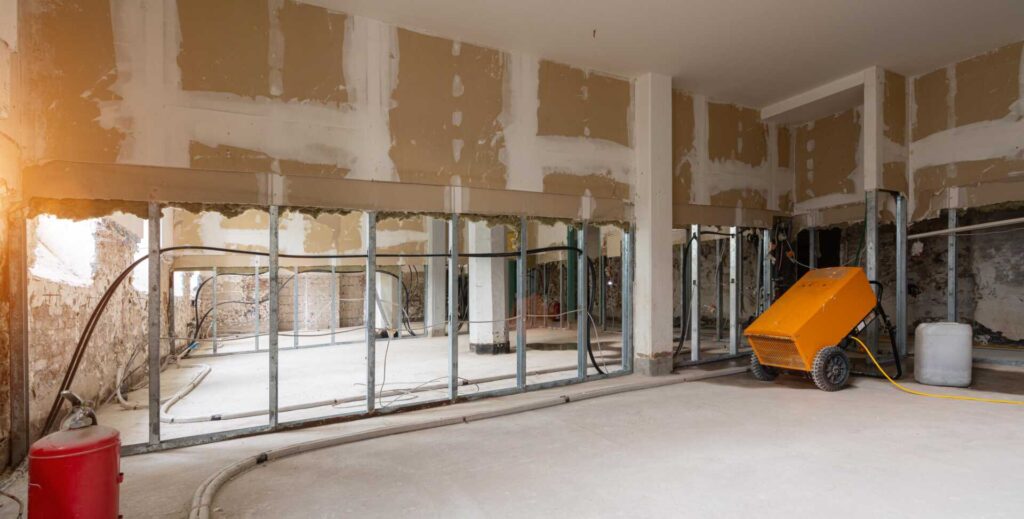
Contents
It’s vital to act quickly and effectively after a flood. Understanding the right steps and tools can make all the difference in protecting your home and health. What strategies can you implement to prevent water damage and the lurking threat of mold? Let’s explore the essential actions you can take.
Key Takeaways
- Assess and document flood damage promptly to facilitate effective cleanup and insurance claims.
- Utilize wet/dry vacuums and submersible pumps for efficient water extraction.
- Implement dehumidifiers and maintain humidity levels below 60% to prevent mold growth.
- Regularly inspect and maintain ventilation systems to control moisture and enhance air circulation.
- Engage in community preparedness initiatives to strengthen flood resilience and recovery efforts.
Understanding the Impact of Spring Floods
As spring arrives, many communities face the harsh reality of floods, which can devastate homes and disrupt lives. You might notice that flood frequency has increased in recent years, a trend closely tied to climate change. Warmer temperatures lead to more intense storms and unpredictable weather patterns, leaving neighborhoods vulnerable.
Understanding this impact is vital for you and your community. Flooding doesn’t just damage property; it can displace families, strain local resources, and create long-term health risks. It’s important to recognize that these events are becoming more common, and as a member of your community, you should advocate for better preparedness and resilience strategies.
Take a moment to reflect on how your community can come together to address these challenges. By fostering a sense of belonging and collective responsibility, you can help build a safer environment for everyone facing the threat of spring floods.
Immediate Steps to Take After Flooding
Once the waters recede, it’s crucial to act swiftly to minimize damage and protect your health. Start by contacting local resources and emergency contacts to assess your situation. Time is of the essence when it comes to preventing long-term issues like mold growth.
Here are the immediate steps you should take:
Inspect your property for visible damage and hazards.
Document everything with photos for insurance claims.
Remove standing water using buckets or a pump—safety first!
Ventilate the area by opening windows and using fans to dry out spaces.
Consult professionals if you’re unsure about safety or cleanup procedures.
Essential Tools for Effective Water Extraction
When tackling water extraction after a flood, having the right tools can make all the difference in restoring your home efficiently.
You’ll need powerful wet/dry vacuums that can handle large volumes of water. These vacuums are essential for the initial water extraction phase, allowing you to remove standing water quickly.
Additionally, submersible pumps are invaluable for deeper water removal. They can help you reach those hard-to-access areas, ensuring no moisture lingers.
Don’t forget about dehumidifiers; they play a vital role in drying out the air and preventing mold growth.
It’s also wise to invest in moisture meters, which help you assess moisture levels in walls and floors.
By using the right cleanup equipment, you’re not just restoring your home; you’re reclaiming your space and peace of mind.
With these tools at your disposal, you’re well-equipped to tackle the aftermath of a flood together with those who understand your journey.
Assessing Water Damage in Your Home
Before diving into the cleanup process, it’s vital to assess the extent of water damage in your home. A thorough water damage assessment helps you understand what you’re facing and guides your next steps.
Here’s what to reflect on:
- Check for visible water stains on walls and ceilings.
- Inspect the flooring for buckling or warping.
- Look for damp areas in hidden spaces, like basements or crawl spaces.
- Evaluate the condition of insulation and drywall.
- Assess the structural integrity of beams and supports.
Taking the time to conduct a detailed evaluation can save you from costly repairs later.
The Importance of Professional Restoration Services
When your home faces water damage, turning to professional restoration services can make all the difference.
Their expertise in damage assessment ensures you won’t overlook hidden issues while advanced cleanup techniques tackle the mess efficiently.
Plus, they implement mold prevention strategies that protect your home in the long run, giving you peace of mind.
Expertise in Damage Assessment
Although flooding can wreak havoc on your home, understanding the extent of the damage often requires a professional’s keen eye.
Skilled restoration experts utilize advanced assessment techniques for accurate damage evaluation, ensuring you don’t miss hidden issues that could worsen over time.
- Thorough inspections to identify structural weaknesses
- Use of moisture meters to detect hidden dampness
- Assessment of electrical and plumbing systems for safety
- Evaluation of personal belongings for restoration potential
- Expert advice on preventing future damage
Advanced Cleanup Techniques
Effective flood cleanup often hinges on employing advanced techniques that go beyond basic drying and cleaning.
You’ll find that professional restoration services utilize advanced drying techniques, ensuring that every nook and cranny is thoroughly dried, preventing long-term damage.
These experts also implement innovative cleanup methods, like thermal imaging, to identify hidden moisture and specialized equipment to tackle stubborn stains and odors.
By relying on trained professionals, you’re not just cleaning up; you’re investing in the health and safety of your home.
They can ensure that the job is done right, creating a sense of belonging and security for you and your loved ones.
Don’t underestimate the value of expert help during this challenging time. Your peace of mind is worth it.
Mold Prevention Strategies
Mold can develop rapidly in the wake of a flood, making it crucial to act quickly and strategically to prevent its growth. By implementing effective mold prevention strategies, you can protect your home and loved ones.
Here are some key steps to contemplate:
- Utilize mold identification techniques to spot early signs of growth.
- Invest in moisture monitoring systems to keep humidity levels in check.
- Ensure proper ventilation in all areas, especially basements and attics.
- Regularly inspect plumbing and appliances for leaks.
- Work with professional restoration services for thorough assessments and remediation.
Taking these proactive measures safeguards your environment and fosters a sense of community.
Preventing Mold Growth After Water Damage
After experiencing water damage, you’re facing a vital window to prevent mold growth.
Acting quickly with prompt water removal, ensuring proper ventilation, and controlling humidity can make all the difference.
Let’s explore these essential steps to protect your home from unwanted mold infestations.
Prompt Water Removal
When water damage strikes, acting quickly can be the difference between a minor inconvenience and a major disaster.
You need to prioritize prompt water removal to prevent mold growth. Here’s what you should focus on:
Water extraction: Remove standing water immediately to minimize damage.
Rapid drying: Use fans and dehumidifiers to dry out affected areas quickly.
Inspect for hidden moisture: Check behind walls and under floors to ensure thorough drying.
Remove damaged materials: Discard soaked carpets and drywall to reduce mold risk.
Monitor humidity levels: Keep indoor humidity below 60% to deter mold growth.
Proper Ventilation Techniques
To effectively prevent mold growth following water damage, ensuring proper ventilation is essential.
You can adopt various ventilation methods to enhance airflow management in your home. Start by opening windows and doors to create cross-ventilation, allowing fresh air to flow through affected areas.
Using fans strategically can also help circulate air and speed up drying. If possible, consider using dehumidifiers, as they remove moisture and improve air movement.
Remember, stagnant air is a breeding ground for mold.
You’re not alone in this; many homeowners have successfully implemented these techniques, reclaiming their spaces from potential mold infestations.
Humidity Control Measures
Since high humidity levels can create an ideal environment for mold to thrive, controlling moisture in your home is vital after any water damage.
Implementing effective humidity control measures will protect your space and provide peace of mind.
Here are some key strategies for moisture management:
- Use dehumidifiers to keep humidity levels below 60%
- Ensure proper ventilation in all rooms, especially bathrooms and kitchens
- Seal any leaks in windows, doors, or roofs
- Regularly check and maintain your HVAC system
- Monitor indoor humidity with hygrometers to stay informed
Long-Term Strategies for Flood Preparedness
While many homeowners react to flooding with immediate cleanup efforts, it’s essential to adopt long-term strategies for flood preparedness that can make a significant difference in safeguarding your property.
Start by securing thorough flood insurance; it’s a safety net and a critical tool for recovery. Next, invest in your community’s preparedness initiatives. Join local organizations focused on flood resilience—these connections can provide support and resources when disasters strike.
Elevate your home’s infrastructure by installing sump pumps and flood barriers, and consider landscaping that directs water away from your property.
Regularly assess your surroundings, such as drainage systems, to ensure they function effectively.
Resources for Homeowners Facing Flooding Challenges
Flooding can strike unexpectedly, leaving homeowners in urgent need of reliable resources to manage the aftermath.
To navigate these challenges effectively, you can tap into various tools and support systems:
Flood Insurance: Verify you understand your policy and coverage options.
Local Relief Organizations: Seek assistance from community support groups that provide immediate aid.
Restoration Services: Hire professionals who specialize in flood cleanup and mold prevention.
Community Workshops: Attend local seminars that educate on emergency preparedness and recovery.
Online Support Groups: Join forums where you can share experiences and learn from others facing similar challenges.
Wrap-Up
As you stand in the aftermath of flooding, the air thick with uncertainty, remember that every moment counts. The tools and strategies you’ve learned aren’t just for the present; they’re your lifeline against lurking mold and unseen damage. Will you take the necessary steps to safeguard your home and health? The choice is yours, and the clock is ticking. Equip yourself now, and transform this challenge into a story of resilience and recovery that your community can rally around.
Recent Posts
What Are the Top Mold Prevention Tips After Flooding?
You might think mold prevention isn’t a priority after flooding, but it’s essential for your
Essential Mold Prevention Tips Post-Flooding
Imagine standing in a damp, musty room, where the remnants of floodwater linger and the
Ultimate Flood Cleanup and Restoration Strategies
When faced with the aftermath of a flood, it’s essential to approach the flood cleanup
